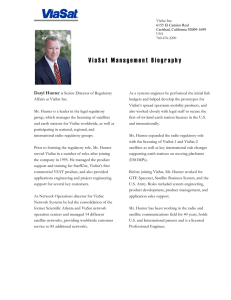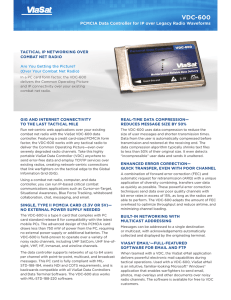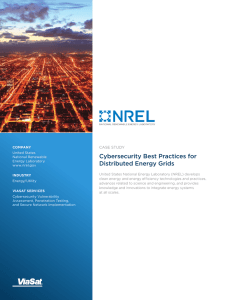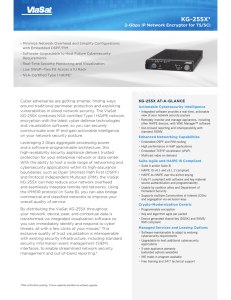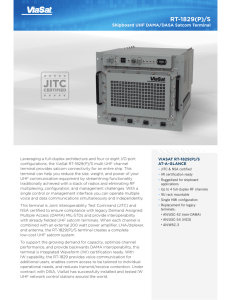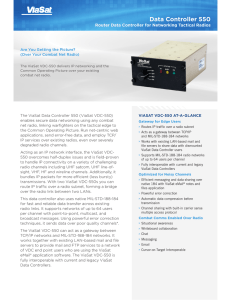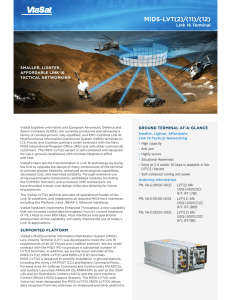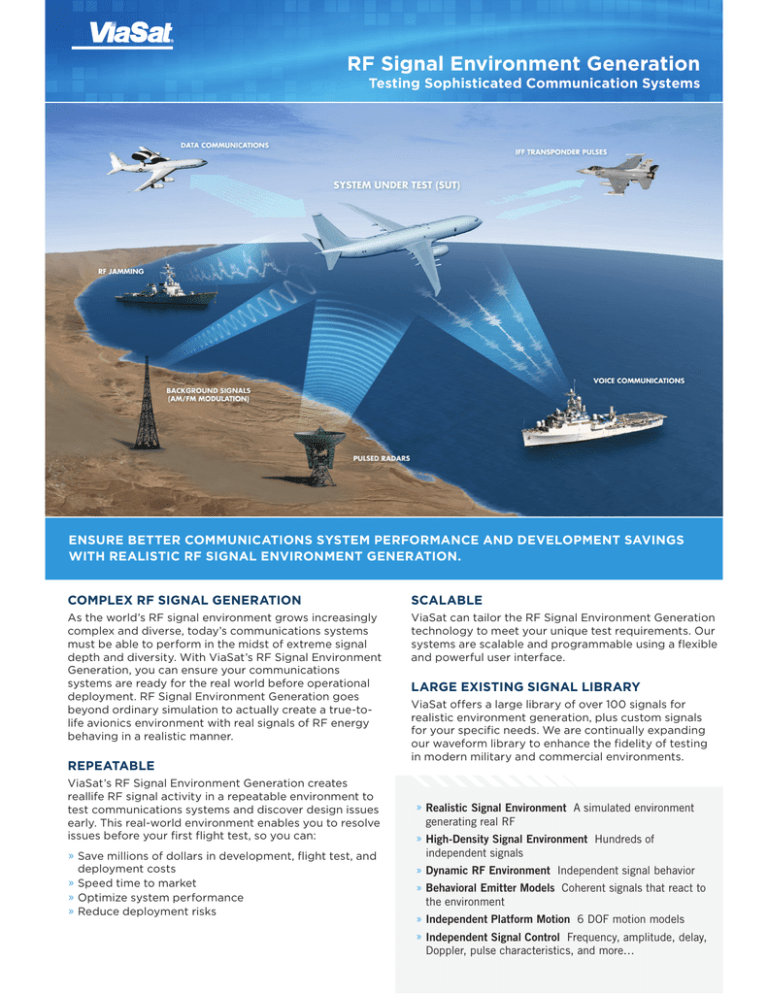
RF Signal Environment Generation
Testing Sophisticated Communication Systems
ENSURE BETTER COMMUNICATIONS SYSTEM PERFORMANCE AND DEVELOPMENT SAVINGS
WITH REALISTIC RF SIGNAL ENVIRONMENT GENERATION.
COMPLEX RF SIGNAL GENERATION
SCALABLE
As the world’s RF signal environment grows increasingly
complex and diverse, today’s communications systems
must be able to perform in the midst of extreme signal
depth and diversity. With ViaSat’s RF Signal Environment
Generation, you can ensure your communications
systems are ready for the real world before operational
deployment. RF Signal Environment Generation goes
beyond ordinary simulation to actually create a true-tolife avionics environment with real signals of RF energy
behaving in a realistic manner.
ViaSat can tailor the RF Signal Environment Generation
technology to meet your unique test requirements. Our
systems are scalable and programmable using a flexible
and powerful user interface.
REPEATABLE
ViaSat’s RF Signal Environment Generation creates
reallife RF signal activity in a repeatable environment to
test communications systems and discover design issues
early. This real-world environment enables you to resolve
issues before your first flight test, so you can:
»»Save millions of dollars in development, flight test, and
deployment costs
»»Speed time to market
»»Optimize system performance
»»Reduce deployment risks
LARGE EXISTING SIGNAL LIBRARY
ViaSat offers a large library of over 100 signals for
realistic environment generation, plus custom signals
for your specific needs. We are continually expanding
our waveform library to enhance the fidelity of testing
in modern military and commercial environments.
»» Realistic Signal Environment A simulated environment
generating real RF
»» High-Density Signal Environment Hundreds of
independent signals
»» Dynamic RF Environment Independent signal behavior
»» Behavioral Emitter Models Coherent signals that react to
the environment
»» Independent Platform Motion 6 DOF motion models
»» Independent Signal Control Frequency, amplitude, delay,
Doppler, pulse characteristics, and more…
RF Signal Stimulation
RF SIGNAL GENERATION EXPERIENCE
RF SIGNAL ENVIRONMENT GENERATORS FOR A
VARIETY OF TESTING:
For over 20 years, systems designers have relied on
ViaSat’s signal modeling expertise to help successfully
launch better avionics and communications systems. RF
Signal Environment Generation can shake out design
problems during developmental testing in a trueto-life environment. Signal scenarios are controlled,
repeatable and dynamic to help you optimize your
system’s performance. ViaSat has delivered large-scale
systems for platforms including the F-22 and F-35.
»» Save millions of dollars in development costs
»» Speed time to market
»» Optimize system performance
BUILDING AN RF SIGNAL ENVIRONMENT GENERATION SCENARIO
USER MAIN MENU
SCENARIO
SITE
SYSTEM UNDER
TEST (SUT)
PLATFORM
MODEL
DATA
BUILT-INTEST (BIT)
Adjust and control every aspect of the RF environment
generation via the system’s intuitive user interface.
Begin by defining the physical location of the desired
RF environment. The “scenario” can be at any
geographic location in the world. The system uses a
Defense Terrain/Elevation Database (DTED) to provide
real-world topography. You can then place static or
dynamic “platforms” (objects) in the scenario.
Dynamic motion can be established through set
velocity parameters or via waypoint definition.
Computation of dynamic platform position uses a six
degrees of freedom (6-DOF) motion model that tracks
both position and attitude of the platform with update
rates as high as 100 Hz.
Next, you can add “emitters” to the platforms, defining
all the transmitted signals from the real-world objects.
The user interface enables you to select from a
set of emitter modulation types and also associate
an antenna pattern with the emitter. The antenna
patterns can be selected from our pre-defined data
base or imported to represent custom antennas in a
high-fidelity gain pattern modeled by an azimuth and
elevation look-up table.
YAW
Z
Y
PITCH
X
ROLL
SIX-DEGREE-OF-FREEDOM MOTION MODEL:
• LATITUDE, LONGITUDE, AND ALTITUDE (X,Y, AND Z)
• ROLL, PITCH, AND YAW EULER ANGLES
CALIBRATION
EMITTER
ANTENNA
OPTION
Platform and emitter models can be replicated throughout
the scenario to create a high-density, real-world RF
environment. The system supports predefined platform
models that represent real-world objects such as an air
defense network. The technology offers emitter behavioral
models, changing modes, turning transmissions on and off,
and setting fixed power levels at specified times.
The system under test (SUT) is also defined using emitter
and antenna models. The SUT can be either static or
dynamic using the 6-DOF motion models. You can also
import detailed antenna models that reflect the unique
features of your communication system. For complex
systems, this can include multiple antenna patterns that
feed into multiple sensors on a specific platform.
During run time, the system generates the correct
amplitude, frequency, and pulse characteristics for each
transmitted signal of each platform. For a SUT with
interferometer sensors, accurate signal phase is also
presented to each antenna port. The operator has the
flexibility to stop and resume a scenario, as well as to
make dynamic changes to platforms and emitters during
run time. This virtual environment emulates the real-world
RF environment to the SUT with a high degree of fidelity,
flexibility, and repeatability.
RF SIMULATOR CONTROLLER
User Interface GUI
SYSTEM
UNDER
TEST
(SUT)
EXTERNAL CONTROL
External Control
OUTPUT DATA
Graphical Displays and Data
INTERACTIVE EMITTER CONTROL (SUT TRANSPOND REQUESTS)
Real-Time Control
RF
EMBEDDED PROCESSING
SIGNAL GENERATORS
Geometry Processing
Communication Signals
Signal Event Processing
Navigation Signals
Real-Time Processing
Identification Signals
Resource Allocation
Background Signals
1
RF
RF
RF
1
2
n
RF NETWORKS
Amplitude Control
2
Frequency Control
Phase Control
n
Signal Combining
RF SIGNAL ENVIRONMENT GENERATION ARCHITECTURE FOR YOUR SPECIFIC NEEDS
ViaSat's RF generation technology provides a
mature development environment for custom user
requirements. We offer engineered-to-order systems,
with customer-driven requirements for signal types,
processing throughput, interfaces to other systems,
quantities of signal generation elements, and RF
networks and output ports. Our architecture facilitates
scalability and extensions to the existing stimulator
signal set and functionality. The RF Stimulator
Controller hosts the Graphical User Interface (GUI) for
scenario development, data storage and display, and
real-time scenario control.
Embedded processors perform the computationally
intensive tasks of platform motion and geometry
calculations between the scenario platforms and the
SUT. The embedded processing components also
keep the timing for signals and control the parameters
for the programmable signal generators.
The signal generation uses a unique arbitrary
waveform generator subsystem to emulate a wide
variety of pulsed and continuous RF waveforms. The
signal generators output the waveforms at baseband
with rates as high as 40 Megasamples/second.
ViaSat offers a large library of over 100 signals for
realistic environment simulation. ViaSat’s experienced
signal modeling team can also leverage our flexible
stimulation architecture to develop additional
waveforms for your needs.
ViaSat’s RF signal generation architecture provides a
scalable and flexible test and evaluation environment
for your communication system. Using the baseband
signals, RF networks adjust the amplitude, frequency,
and phase of the signals based on the geometry,
range, and antenna characteristics of the platforms
and the SUT. The technology supports signal
generation from as low as 500 kHz up to as high as
18 GHz. Frequency is controllable in 1 Hz increments.
As the communication system designer, you can
determine the number of signal generators based
on the required signal density of the real-world
application. Multiple emitter signals are combined
to present a composite signal to the SUT. You can
also specify the number of RF output ports, which
correlates to the number of input antenna ports
needed to stimulate the SUT. The phase control
of the signal allows directional sensing from an
interferometer to an accuracy of one degree.
The physical configuration of the system is highly
dependent on the specific customer requirements for
signal density and communication system complexity.
ViaSat has delivered customized systems in many
forms, ranging from a one-device system to over a
dozen racks. We continue to develop smaller and even
more modular stimulators that promise additional
flexibility for your needs.
Testing with ViaSat's RF Signal Environment
Generation reduces net system costs by lowering the
probability and risks of discovering and fixing design
problems after fielding a communication system.
RF Signal Stimulation
The ViaSat RF Stimulation engineering team is committed to helping you successfully design and launch your
complex communication system. We deliver the highest quality RF stimulators for your communication system
testing needs, to help you reap tremendous savings in time and development costs, while ensuring optimal
system performance.
LARGE-SCALE RF ENVIRONMENT GENERATOR
PORTABLE RF SIGNAL ENVIRONMENT GENERATOR
VRG-1000
PORTABLE IFF ENVIRONMENT GENERATOR
CONTACT
SALES
TEL +1 760 476 2506
FAX +1 760 929 3962
EMAIL rf.environment@viasat.com
UNITED STATES Carlsbad, CA & Washington, DC TEL +1 760 476 4755
UNITED KINGDOM Wareham
AUSTRALIA Canberra
TEL +44 0 1929 55 44 00
TEL +61 0 2 61639200
WEB www.viasat.com
FAX +1 760 683 6815
FAX +44 0 1929 55 25 25
EMAIL insidesales@viasat.com
EMAIL sales@viasat.uk.com
EMAIL gov.australia@viasat.com
Copyright © 2011-2013 ViaSat, Inc. All rights reserved. ViaSat and the ViaSat logo are registered trademarks of ViaSat, Inc. All other trademarks mentioned are the sole property of their respective companies. Specifications and
product availability are subject to change without notice. 028-121121-017

